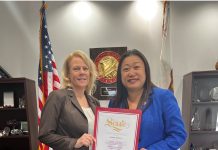Like Laguna Beach, at least 30 other cities and water districts in the state have turned off the tap and prohibited the filling of new swimming pools since the governor called for a mandatory 25 percent cut in water use earlier this year.
Builders call the construction bans a symbolic prohibition that unfairly discriminates against a single industry even though cities have yet to tamp down on water-guzzling turf.
With figures showing that less water evaporates from a covered pool than is required by drought resistant landscaping, pool builders have set aside their tools to lobby city halls and helped overturn pool-building bans in seven towns, according to data compiled by the California Pool & Spa Association. Claremont, Malibu and Thousand Oaks have since reversed bans.
“I’m trying to save my skin and save water,” said Alan Smith, a pool plasterer from Orange. He intended to make his case for overturning Laguna’s recently imposed ban by meeting with Laguna County Water District officials this past Wednesday.
Twenty-eight projects in Laguna were put on hold due to the 45-day moratorium on new pool construction approved by the City Council on Tuesday, July 14, City Manager John Pietig said.
More swimming pool regulations will be considered at an Aug. 4 meeting, Pietig said.
In a letter to Laguna’s elected city officials, John Norwood, president of the pool association, argues that the city’s pool ban should only be imposed if drought conditions require cutting off outdoor irrigation as well.
“The water required to fill all new swimming pools in Laguna Beach in one year amounts to less than one-hundredth of a single percent of the city’s annual water usage,” Norwood said. About 92 pools have been built in Laguna in the last five years, an association spokeswoman said.
“Pools are not the water-wasters people think they are,” said Smith, adding that the pool association expects to release findings on research to pinpoint the best methods to prevent evaporation.
While Smith thinks cities should urge its residents to use pool covers to manage water loss by evaporation, the pool industry itself has been slow to promote new technology that can make a huge impact on consumption, Smith said.
Commercial pool managers routinely siphon off chlorinated water and refill pools with fresh water to dilute solids that gum up filtration systems, said Smith.
He’s turned to new technology that circumvents standard industry practice to drain pools annually for the longevity of filtration systems. Instead, chlorinated pool water can be purified through reverse osmosis pumped through a mobile truck that then recirculates the cleaned water back into the pool.
“Nobody was buying into it,” Smith said. Such a process costs from $700 to $1,200 to cleanse the water of a typical 20,000-gallon backyard pool, he said. “I’ve been looking at this technology for years,” he said.
There is another reason Laguna shouldn’t ban pools, Smith said. They can serve as useful reservoirs that fire fighters can tap to quench blazes when they lose water pressure, he pointed out.





[…] Sacramento. Pool builders support mandating pool covers to reduce water evaporation, he said, but oppose banning new pools since there are better ways to conserve water that don’t cost jobs or put people out of […]